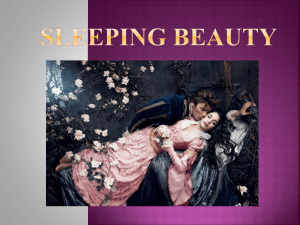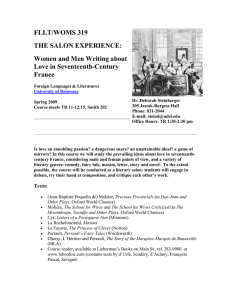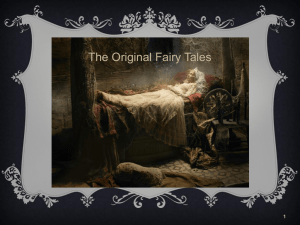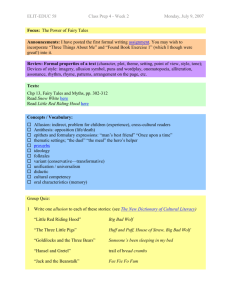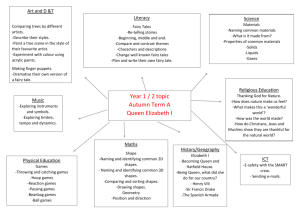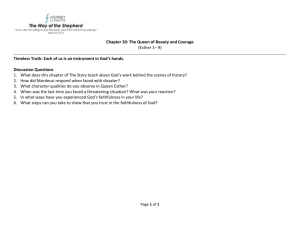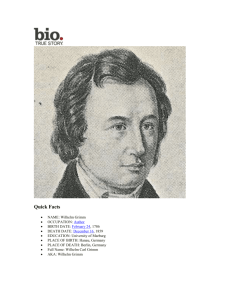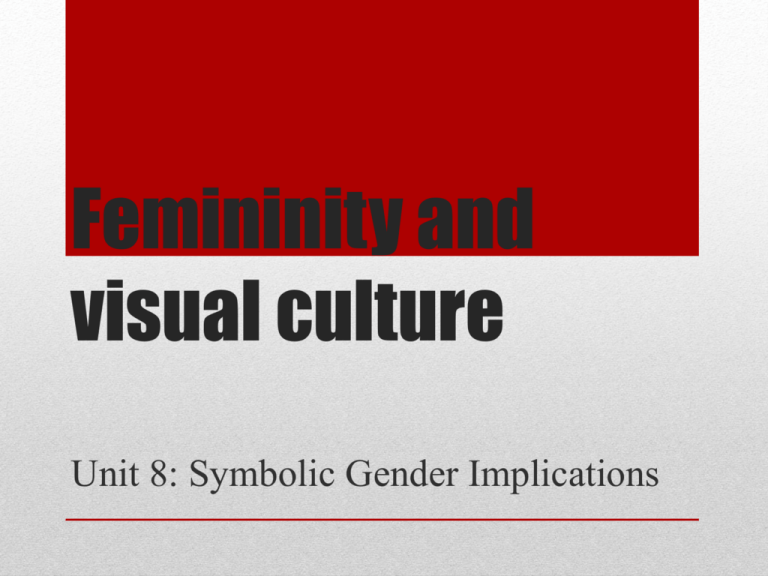
Femininity and
visual culture
Unit 8: Symbolic Gender Implications
Charles Perrault
The Grimm Brothers
• stories published in 1697, as
a manifest in favor of the
moderns, in the quarrel
between the Antics
(literature should be revived
by learning from the
classics) and the Moderns
(literature should be revived
by folklore and paganism)
• specific: a mix of elements
addressed to adults and
elements addressed to
children: family conflicts,
educational melodrama,
sophisticated comments and
sexual innuendos
• collection of folk tales (1812) =
academic project of „recovery of the
German soul and language”
• criticized by August Wilhelm Schlegel
(„too vulgar”)
• re-written for the children in 1825: less
sexuality (does not include the story of the
boy who impregnates women by simply
wishing it, Hans the Stupid, etc.), but more
violence
EX. Rapunzel first edition: the daily
encounters with the prince end up in a
pregnancy: "why are my clothes no longer
fitting me?”// second edition: „I am heavier
than the prince who has to climb the tower”
• VIOLENCE = educational punishment
Fairy tales collections
• orig. „hat, cap” (the „red” is introduced by Perrault
in his literary version, it is not present in the folk
tale)
• in oral folk versions it is pornographic, the Red
Riding Hood performs a striptease in front of the
wolf, enumerating significant parts of the body and
then asking if she can go out and satisfy her
physiological needs
• as a fairy tale, it replaces the erotic anecdote with
the lesson on the importance of obedience
• symbolic meanings possible to explore: a double
rape scene, hatred towards men as sexual predators,
learning how to become a woman
The Red Riding Hood
• the anxiety of not being devoured,
educational rules (stay on the right
track) are added by the Grimm
brothers
• the wolf – fulfills the role of the
cannibal ogre, in order to educate the
fear of lurking dangers (the wild
animal, the ware-wolf etc.), but also
of the masculine seducer
• "Oh, Grandmother, what big ears you
have!"- invoking the senses, in
pornographic versions – also the
genitals (games of gradual undressing)
• „he leaped out of bed and gobbled up
poor Little Red Riding Hood” –
symbolic death, followed by the
initiatic rebirth in femininity
• symbolic castration or maternity envy
A story of engulfment
• the second part of the title is introduced by
Charles Perrault, in 1697
• there is a certain ambiguity between a voir
shoe (old for fur) and a verre shoe (glass), but
in the end it is settled in favor of glass, crystal.
In a symbolic reading, both of them had sexual
connotations (the pubis and the hymen)
• no name, no mother, absent father: no
masculine authority reglementing motherly
evil
• the ashes: a dormant identity, after the
consummation of the old, lively one. Also:
grey = neutrality, absolutely necessary to a
successful initiation of the neophyte (the nonidentity, the intermediate stage of passage
rites)
Cinderella or the Little Glass
Slipper
• the help and savior of the poor girl
comes, in the Grimm brothers
version, in the form of a tree (magic
entity) and in Perrault's the
godmother offers the carriage,
servant and garments
• sibling rivalry, feminine jealousy, the
Grimms: blood in the sisters’ slippers
(violent, self-induced defloration,
rituals of symbolic defloration). The
German folk version: pigeons pick
the sisters’ eyes at the wedding,
painfully blinding them
Sibling rivalry
Sisters = images of self, in
deprecating, negative terms
• Jacob and Wilhelm Grimm, 1812):
• EVIL QUEEN:
• Grimms' evil queen orders the huntsman to return with the girl's lungs and liver, both of which
she plans to eat after boiling them in salt water
• In Spain, the queen asks for a bottle of the girl’s blood with her toe as a lid
• In Italy, she asks for her intestines and coat soaked in her blood.
• COFFIN:
• In Disney's film: crystal coffin, in other versions: gold, silver or lead, with precious stones
• It is placed on top of a mountain, under a tree, locked in a room with candles or floating on a
river.
• CONFLICT MOTHER - DAUGHTER
• the stepmother = an imaginary effort to protect mother’s sanctity, by separating her in a good
mother (closed in the ebony frame, sowing and contemplating locked behind a glass
transparence) and a bad mother
• mirror = separation (captive by means of narcissistic desire, but also mobile and active, locked
behind reflective glass)
• Snow White is put on aesthetic display in a glass coffin seems to refer back to both the
window and the looking glass of the two mothers
Snow White
• „Who's the fairest
one of all?” –
judgmental voice
(probably the everabsent father,
patriarchal
assessment of
beauty)
• - „When she
reached the age of
seven” - symbolic
puberty,
incompatible with
the final marriage –
social puberty
„Finds the bed that is just right for
her” – adequate refuge, promise of a
marriage (unlike Disney's dwarfs, the
dwarfs in brothers Grimm’s brothers
are not different from one another.
Their diminutive stature - eunuchs,
sexually non-threatening, making her
even more attractive).
„You will keep house for us” –
domestic initiation, beyond childhood,
in preparation of conjugal statute
- the victim of maternal duplicity (the
queen in disguise wins the girl’s trust
by faking motherhood).
The Apple - the Paradise apple, also
„white with red cheeks”, like Snow
White herself
Hidden messages
"White as snow, red as
blood, black as ebony" -the
stepmother's invocation of
the first queen's fantasy
about her child points to the
underlying identity of the
biological mother and the
evil queen.
„Wrote her name on it in
golden letters” - becomes an
exhibit. Comes back to life
with true love’s kiss (also:
the servants trip, the apple
comes out, possibly showing
stifling influence of the
dwarfs).
Oueen’s death: the Grimms in pain and humiliation,
tortured in a crazy dance
(versus the immobility of
Snow White)
Sleeping Beauty
• Jacob and Wilhelm Grimm, 1812).
• modified version of Giambattista
Basile, "Sun, Moon and Talia"
(1636) and the story of Charles
Perrault, "Sleeping Beauty in the
Wood" (1697). In Basile s story
Talia (whose name derives from the
Greek word Thaleia, meaning "the
blossoming one") gets a tiny piece of
flax under her fingernail and falls
down dead. The king who discovers
Talia in an abandoned castle is
already married, but he is so
overcome with desire for her that he
"plucks from her the fruits of love"
while she is still asleep. Talia is
awakened from her deep sleep when
one of the two infants to which she
gives birth, exactly nine months after
the king's visit, sucks the piece of
flax from her finger. When the king's
wife leams about Talia and her two
children, Sun and Moon, (see Doi
feți cu stea în frunte) she orders their
deaths, but she herself perishes in the
fire she prepares for Talia, and the
others live happily ever after.
• Perrault's "Sleeping Beauty in the Wood" is awakened when a prince kneels before her, and
the two carry on a love affair that produces a daughter named Aurora and a son named Day.
Although the prince marries Sleeping Beauty, he is soon summoned to battle and entrusts his
wife and children to the care of his mother, who is descended from a "race of ogres”. The
mother's cannibalistic inclinations get the better of her, but a compassionate steward spares the
lives of mother and children, substituting animals for the humans. In the end, the queen, caught
in the act, flings herself headfirst into a vat filled with "toads, vipers, adders, and serpents”,
• Theme of a hibernating identity until „the time is ripe”
• Postmarital conflict (Italian and the French versions) what happens after marriage
„quintessential female heroine of fairy tales”
• Incapacity to conceive = direct result of parents’reckless decisions (Perrault: beauty, angelic
disposition, grace, perfect dancing skills, the voice of a nightingale, the ability to perfectly play
any instrument = the ideal woman).
• „She had not been invited, and now she wanted her revenge” - Eris’ revenge, uninvited at the
wedding of Peleus and Thetis, throwing the apple of discord that leads to the Trojan war
• „A little door with a rusty old key in its lock.” - curiosity and fascination for the spindle are
blamed, while the prince is being rewarded for his curiosity
• Crucial age of passage rite – 15 years old
• „I'm spinning flax.„- as the Parcae, who measure life + the act of telling stories + standard
symbols of feminine domesticity (present in nuptial processions)
• The unchosen princes „died an agonizing death” in thorns (maybe a paternal punishment)
• „They opened to make a path for him” - disappearance of obstacles from the chosen’s way
(sexual and emotional maturation, identity in bloom, defloration - red roses grow instantly
instead of thorns)
A tale of destiny
• Unlike modern stories, traditional fairy tales, such as those
collected by the Grimm brothers or Charles Perrault are
factual deposits of ritualized forms of life. Rituals of
initiation into puberty mark the passage to a new identity as
women or men. They are still coded in fairy tales, informing
of a sacred level of community life.
© Prof. Mihaela Ursa
Conclusion

